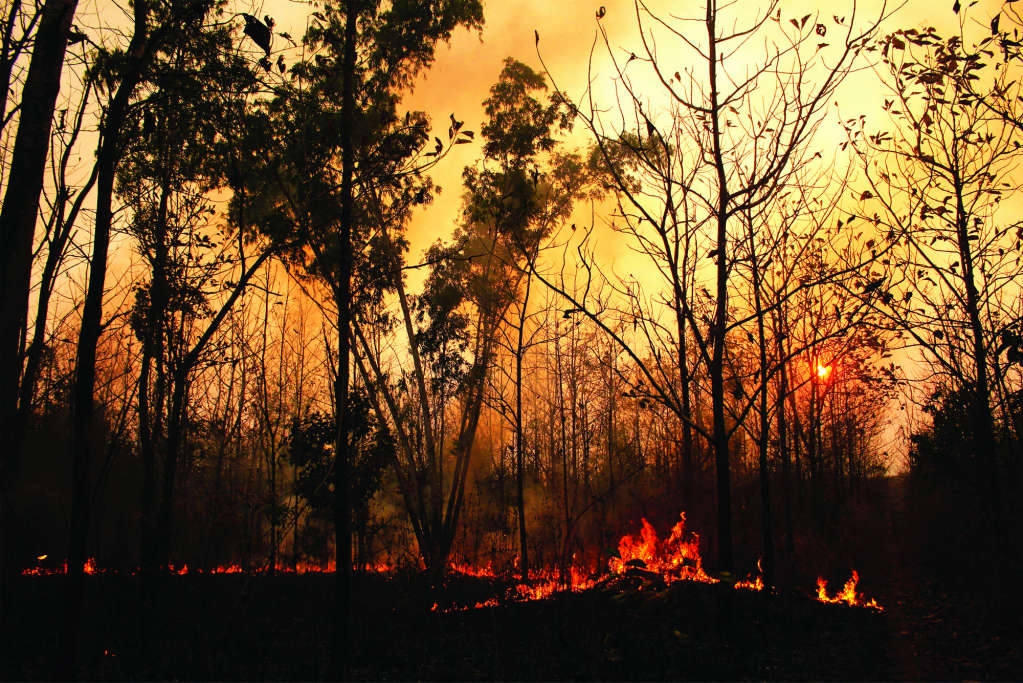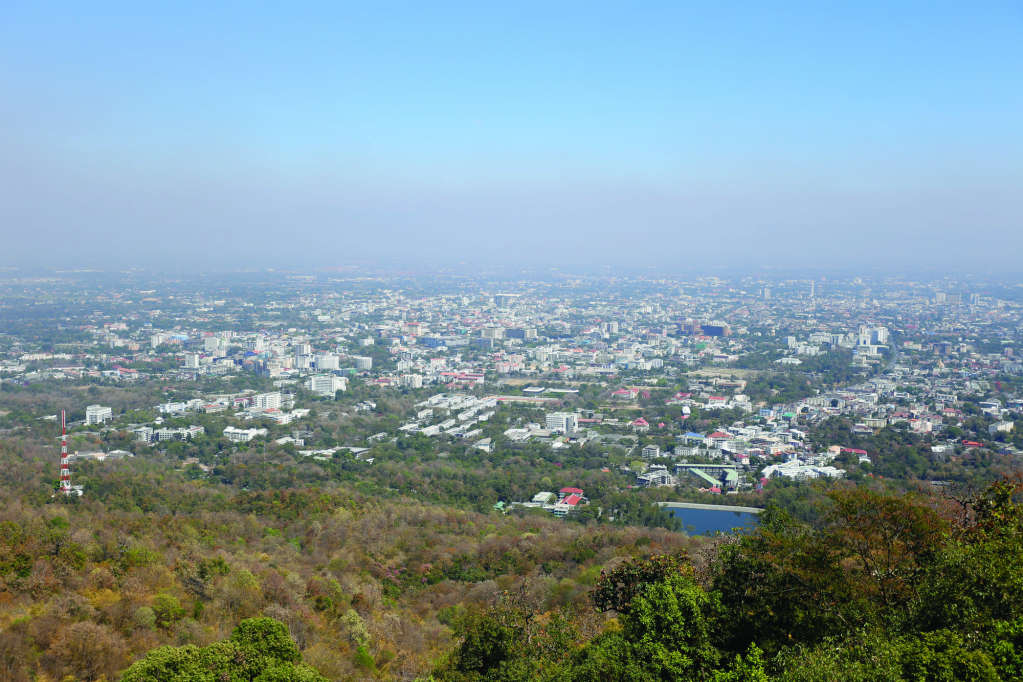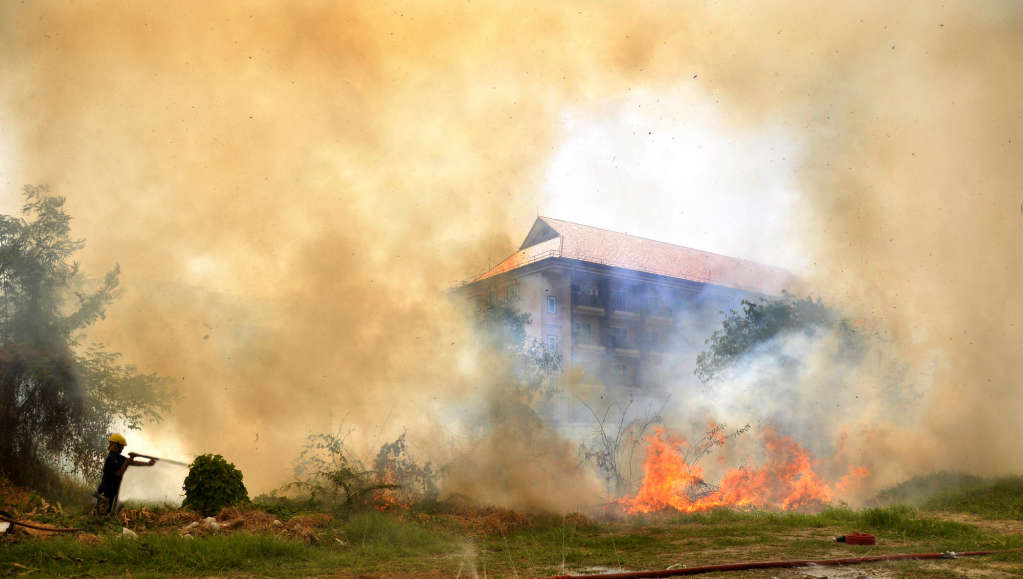It is The Smog – the environmental fiasco year after year seeping into our lungs, our hearts, our eyes and our lives around late-February and extending its visit into the Songkran festivities. Breaths become shallower and outdoor activities lose their attraction; governmental scrutiny intensifies and Facebook becomes a hub for the latest pollution grievances. But this should not be our “normal” – 2015 needs to be the year of forward thinking.
Bicycle and motorbike riders, native and foreign, complain of dry, irritated eyes and raspy voices; chest pains and laboured breathing ensue; cardiovascular conditions escalate and city appreciation falls flat. A new resident admits that, because of The Smog, “Chiang Mai is not what I expected it to be.” A long term resident claims that in the 35 years he has lived here “it has NEVER been this bad.”
We can no longer enjoy the picturesque sunset view of Doi Suthep, and instead stare at the hazy, red ball sinking towards the vague mountain outline (if we can see it at all) through a sea of grey. Limited visibility reverses flights and complicates travel plans. Schools reach double-digits of “Red Days” and children are trapped indoors, unable to go outside.

Medical Nightmares
The Thai government abides by a safety PM10 level of 120 micrograms per cubic metre, which is already significantly higher than that of western countries, but The Smog shows no mercy. PM10 levels in and around Chiang Mai have fluctuated from close to 100 to over 250 during mid-March.
Associate Professor Chaicharn Pothirat, of the Division of Pulmonary, Critical Care and Allergy at Chiang Mai University’s Faculty of Medicine, presented research at a recent seminar on smog solutions concluding that with each 10 mg/m3 increase in PM10, there is a 3.4 percent increase in respiratory mortality, a three percent increase in lower respiratory tract symptoms and a three percent increase in asthma attacks.
Air pollution remains one of the top causes of death in several Asian Pacific countries. Singapore, India, Malaysia, China, Indonesia and Burma have all suffered their fair share of poisoning from vehicle exhaust, factory emissions and forest, garbage, and agricultural waste fires. Greenhouse gases, carcinogens, ozone toxins and dangerous dioxins make a deep breath outdoors comparable to taking a drag of a lunch-break cigarette.
Where There’s Smoke
Most logical Chiang Mai residents blame The Smog on fires. Though, of course, a few bizarre responses should still be expected.
For example, the Chiang Mai Municipality recently pointed the finger at the increase in outdoor city cooking as a contributor to our air pollution problems…
Sakda Darawan, director of Raks Mae Ping, a local environmental activist group, outlines the problem areas. Practices stemming from the “Old Days,” where small farmers burned by-product without consequence, have expanded to a scale that is no longer as harmless.
Several big businesses, like the corn industry, take advantage of rapidly growing contract farming by burning wide forest areas to prepare for new plantations. Both agricultural industries and ground-level consumers who purchase these crops inadvertently support environmental burning disasters like massive deforestation and soil erosion. Company tycoons may at first appear detached from farming alternatives in the field, but in reality, business heads individually make ignorant professional decisions that multiply to affect the health and welfare of the entire nation.

The FIRMS Web Fire Mapper (above), courtesy of NASA, shows evidence of blazes nationwide, which Sakda says are due to burning agricultural waste and hunting for mushrooms (more on that later). This snapshot, taken on March 10th after the ruinous 255 PM10 reading, showcases Eastern Asia over 48 hours.
In a recent interview with Citylife, Chiang Mai Governor Suriya Prasartbandit remarked that the annual smog “comes with the wind, so it will go with the wind.” But in fact, the increase in dangerous pollution particles, the flames and our lung cancer do not “go with the wind,” but correlate with the sea of red shown on the map.
A Foggy Response
Where has the government been? A two-month ban on burning, hefty fines for lawbreakers, a series of fire-reporting hotlines, medical advisories left and right, and the city is currently being watered down from all angles.
Sound legitimate? On paper. But in reality, fire reporting hotlines often prove unsuccessful (not to mention unanswered). Governor Suriya admits that by the time the response team arrives, “the perpetrator is long gone,” if a vehicle can even access the site at all. Arrests made thus far in 2015 are in the single digits, which seems ridiculous given the number of fires running rampant in the mountains that surround Chiang Mai, but do not worry, says the governor, there are “more to come.”
This year, the city’s reactions have been the same as every year: trucks spraying water into the air to disperse smog particles closer to the ground, while planes periodically spread chemically-induced artificial rain miles above. The Chiang Mai Provincial Public Health Office hands out tens of thousands of face masks (which many say do not protect against the most dangerous particles), and officials advise us to remain indoors, seal windows and doors, and do not forget to turn on your central air. Hold your breath outside. Hibernate.
Band-Aids on Bullet Holes
These are not all irrational solutions. Burning is the problem? Ban burning. The public wants to help? Set up a phone line. The Smog is here? Spray water on it. But despite it all, the problem is becoming worse, not better. Which leads us to one obvious notion: we must change our approach.
“The city is being ruined by the hands of the municipality,” says Sakda, adding that Thai lives must not be deemed valuable if long-term pollution issues are not being taken seriously. Policies and legislation prove that the government is, literally and metaphorically, chasing The Smog, rather than seeking long-term solutions to what is clearly a yearly problem.
The water, the ban, medical suggestions, financial threats – these are quick fixes. Without the finances and manpower to squash every flame, without dozens of planes dropping gallons on the city, without a fresh pair of lungs for each of us, these are not permanent results. These responses are reactionary and not proactive, miniature instead of big-picture. A facemask with holes in it will not prevent The Smog from becoming darker in 2016; those in power need to widen their horizons and think beyond Band-Aid solutions.
As Dr. Wolfram Spreer, a renowned researcher at Chiang Mai University’s Faculty of Agriculture, says, “Doing research on alternatives to burning makes more sense than spreading water into the air.”

Searching for ‘Shrooms
Who starts the fires? The farmers, allegedly. Then we need to see it from their perspective. Dr. Spreer puts it best: “We cannot throw someone into prison for burning without giving [them] an alternative.”
So, let’s talk alternatives. First, the mushrooms. Rev. Dr. Kenneth Dobson, who has studied the situation in the San Pa Tong District where he lives, asserts that “families depend on annual mushroom harvest to provide cash for the year” as “certain kinds of mushrooms sell for more than prime beef, pound for pound.” Hunters burn the trees to make it easier once the first rain comes to harvest the expensive delicacy, “hed thob” (Astraeus hygrometricus), a small, round fungus the size of a large pea.
Governor Suriya considers a mushroom ban “impossible to enforce” and mentioned national parks that allow foraging without burning – “you don’t want to destroy their livelihoods, do you?” Evidently, there is little intention to consider any rational options to help stop mushroom-driven deforestation.
However, Dr. Spreer and Jonathan Schweikle, a Master Degree student working at Chiang Mai University, believe a ban could work. Governmental action could also involve “making whole farms of the mushroom” and organising certain times, places and techniques to gather the delicacies. With an increased selling price, these “legal” opportunities to harvest could attract a wide response.
Dr. Spreer, again, hits home in noting that in order for any of these policies to work, those in power need to devote sufficient funding for good research, confirm effective alternatives, and enforce legislation. Scientists and technicians are doing their part, continually conceiving of valid solutions for change, but can only have so much influence when presented with a defeatist remark such as: “you don’t want to destroy their livelihoods, do you?”
Financial and physical efforts must be expected and lifestyles need to be advanced. These hand-me-down professional strategies are harmful and destructive, but farmers also deserve an incentive. Talking about climate change, explaining individual contribution to The Smog, unenforced burning bans and stern conversations will not work – because what’s in it for those on the ground level?
New Solutions
Harvard-trained Dr. Michael Shafer is the director of the Warm Heart Foundation, a community development non-profit in Phrao. His team, which includes Gordon Hirst, once the Chief Engineer at the Institute for Renewable Energy in Laos, prioritises the farmer’s perspective. Dr. Shafer says the problem is the “concentrated burning at the lowest temperature” on the hillsides; in response, he and his team have come up with an alternative: a new type of agricultural waste chemical destruction called pyrolysis.
The team has designed a portable, pyrolysing kiln that can be broken down and loaded on the back of a small pick-up truck, set up in a rice paddy and made to convert agricultural waste at 700 degrees centigrade into “biochar.” Biochar is a type of charcoal that can be combined with manure and soil, allowed to ferment for a few months, and then mixed into fertiliser for stronger, better producing, healthier, and more resistant crops.
The biochar stays in the ground for years, the yield increase for farmers is dramatic, and pyrolysis “eliminates 90 percent of the smoke and smog precursors.” Everyone wins.
Dr. Shafer’s team is now, in fact, “[taking] the mountain to Mohammed,” as he puts it – travelling to isolated villages with this unit made from sheet metal roofing on their own time and dime and proving to small-scale farmers how low-cost, easy-to-use and safe this system can be.
He acknowledges that “initial reactions from the public will be scepticism,” but also points out that billions of baht in tourism are lost every year at the hands of The Smog. The government can afford to invest in this and, as Dr. Spreer puts it, “address the problem a little more enthusiastically.”
As of now, the project is technically on-point, but needs advertising and financial support. The next step is likely a funded case study isolated to an entire village or province, teaching the advantages of biochar and measuring air quality improvement. Then, government responsibility, adequate funding, alternative implementation and well-enforced legislation are needed.
Amporn Boontan from Sankampaeng has a different but similar approach. Five years ago, she single-handedly conceived The Pyramid Compost Education Project, another burning alternative for farmers. The process involves “making compost in a pyramid shape,” using 17, ten-centimetre layers of alternating dry material (rice straw, corn weed, grass, leaves, etc.) and manure. Instead of burning it, you have to water the pyramid, much like a plant. Then, after only two months, one four-metre wide pyramid can produce about one tonne of compost.
Farmers can sell or re-use the organic compost, strengthening crops, generating a quick cash income, averting burning and embracing environmentally-friendly practices. Right now, confined but successful pyramid sessions are taking off in Huaysai and Ontai villages, and spreading from there.

Fire near Canal Road
A Wake-Up Call
Here’s the problem. Amporn started this innovative solution from scratch, has incessantly reached out to the government, contacted and pleaded without success, and since resolved to complete her work independently. Doctors Michael Shafer, Gordon Hirst and Wolfram Spreer have worked tirelessly, sending samples, conducting trials, analysing technical solutions and creating relationships, at times without any compensation.
And yet the government ignores them all and continues on its wayward path. Bans, trucks spraying water, millions of face masks…they will not work. The government is funnelling money into a chequered pair of pants, adding new, multi-coloured patches to each leg instead of investing in a new pair with new stitching, new fabric and new potential.
Yes, new solutions and long-term thinking will cost money, but these half-baked after-the-fact measures are subjecting Chiang Mai to a slow and painful death. The government is doing without thinking and acting without preparing, when the real solution is staring them in the face: invest in well-founded, scientific solutions, and commit to testing widespread burn-replacing tactics that satisfy the farmer’s immediate needs instead of shaming their practices without a viable alternative.
Tunnel vision has coloured Chiang Mai with The Smog for years. We’re ready to breathe again.
